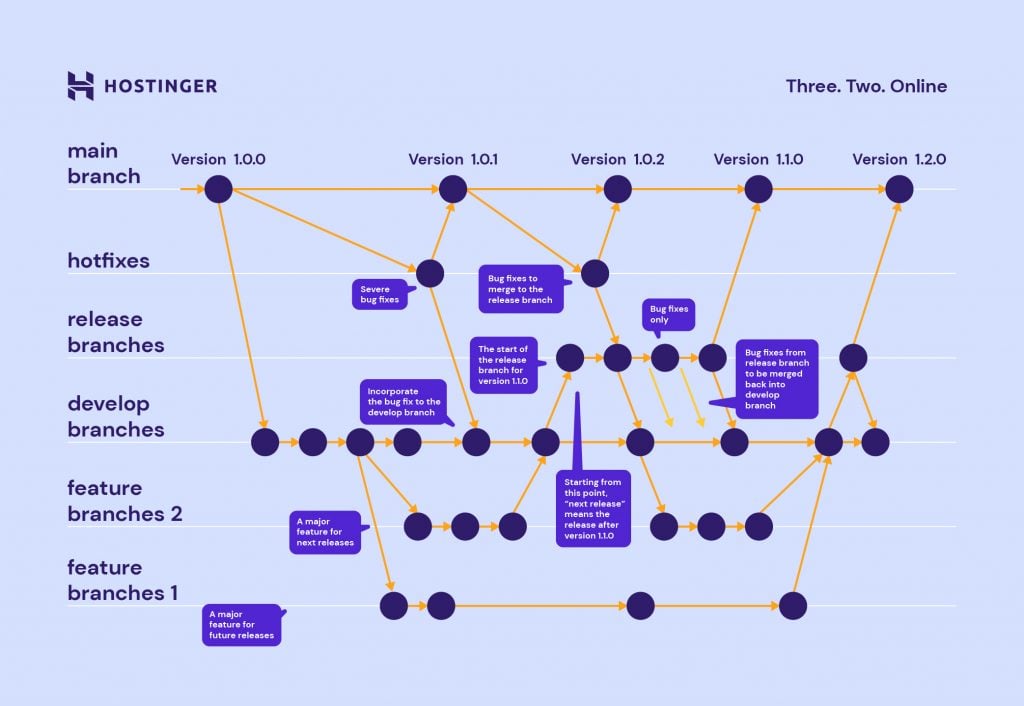How to Use a Git Branch
Git is a tool used by developers to manage version control of their applications. It is highly popular and used by many important projects such as GNOME and others. It is also a fairly efficient application. One of the most important functions of Git is the control of branches of development that help improve the creation of a project. That’s why in this tutorial, we’ll show you how to use Git branches.
Git branches help us have multiple versions of an application organized. That’s why working with them is very important. This tutorial will improve your foundational knowledge of Git.
Download complete GIT cheat sheet
What is a Git Branch
Using Git development branches is a pretty great way to work with our application while tracking its versions. In general, a development branch is a bifurcation of the state of code that creates a new path for the evolution of it. It can be parallel to other Git branches that you can generate. As we can see, it is possible to incorporate new functionalities to our code in an orderly and precise way.
Using Git Branches has multiple advantages. However, we want to emphasize the following two:
- It is possible to develop new features for our application without hindering the development in the main branch.
- With Git branches it is possible to create different development branches that can converge in the same repository. For example, a stable branch, a test branch, and an unstable branch.
Of course, each developer will be able to establish their own methods with their own advantages using experience as a guide.
How to Use a Git Branch
Remember to access your server with SSH before starting! Here’s a PuTTY tutorial to help you out!
The uses of Git’s branches are initially simple as you will notice from the Git branch commands. But as with most things, the more branches you have, the more difficult it might be to manage them.
In any Git project we can view all branches by entering the following command in the command line:
git branch
If there is no branch created, there will be no output in the terminal. Creating a branch is really simple:
git branch [new_branch]
Then, we need to move to the newly created development branch. To do this, we will run the following command:
git checkout [new_branch]
The output will inform us that we switched to a new branch. We called it test, so:
Switched to branch ‘test’
Now, in that new development branch, we can create as many code modifications as we want without having to change anything in the main one. As we can see, it keeps the program organized for new code inclusions.
If we run the command to list the branches again, we will see that a new branch is added and that we are located in it.
git branch
There is something we need to keep in mind if we want to make a new development branch. First, we need to commit to the main branch for Git to understand what the master branch is. If we do not do this, we will get an error. So first, commit and then create the development branches.
If we want to remove a branch from Git, we can do it with the following command:
git branch -d [branch_name]
However, in order to do this, we must not be located on the branch we want to remove. So in this case, we move to the master branch and from there delete the branch we just created:
git checkout master
git branch -d test
Finally, there comes a point where we have made many modifications to a development branch. And it becomes stable, so we want to link it to another development branch. For that, there is the merge command.
First, locate the development branch to which the second branch is to be attached. For example, we will attach the test branch to the master branch. Then, we have to place ourselves in the master branch and merge with the command:
git merge [branch]
As you can see the basic Git branch functions are pretty easy. You just need to know the fundamentals, and try to keep your management clean.
Conclusion
Knowing how to use development branches becomes vital to develop our application in an orderly way. Be mindful of how you organize your code in different Git branches.
In this article, we taught you the basics of how to work with them.
As always, it is advisable to read Git’s official documentation on branches to understand how complex operations are performed. Happy developing!

How to Use Git Branches FAQ
When Should You Use Branches in Git?
Git branches are commonly used when there’s a new feature, bug fix, or anything else in your code you might want to track and compare to previous versions. This helps to identify and track instances where something goes wrong with a bug fix or a new feature release.
How Do I Branch a Repository?
To branch a repository locally, you need to have cloned a version of the repository. Then, in a terminal window, list the branches and create a new feature branch. Switch to this feature branch, work on it and commit the changes to it before switching back to your main repository.


